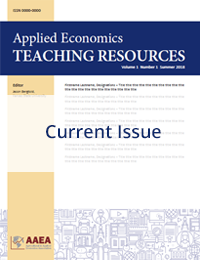Teaching Education Commentary
A Commentary on Extension Education Programming: An Overview of the CattleTrace Extension Program and Graduate Extension Education
Hannah E. Shear
Kansas State University
JEL Codes: Q000
Keywords: Beef cattle, extension, program evaluation, traceability
First Published Online: October 12, 2020
Volume 2, Issue 4
Abstract
This commentary reviews the development of an extension education program within the context of the Agricultural and Applied Economics Association’s Extension Competition. The competition gives graduate students the opportunity to develop extension education skills through the development of an extension education program that focuses on CattleTrace, one of the largest beef-cattle disease tracing programs in the United States. The extension program’s main objective is to identify industry participants and provide them with economic analysis and potential policy impacts relating to CattleTrace. The main outputs of the program include in-person workshops and conferences, informational factsheets, and economic decision tools.
References
Coffey, B., S. Mintert, S. Fox, T. Schroeder, and L. Valentine. 2005. “The Economic Impact of BSE on the U.S. Beef Industry: Product Value Losses, Regulatory Costs, and Consumer Reactions.” Kansas State University Agricultural Experimental Station and Cooperative Extension. https://bookstore.ksre.ksu.edu/pubs/MF2678.pdf.
Cole, Jacquelyn. 1981. “Selecting Extension Teaching Methods.” Journal of Extension September/October 1981. https://www.joe.org/joe/1981september/81-5-a4.pdf.
Golan, E., B. Krissoff, F. Kuchler, L. Calvin, K. Nelson, and G. Price. 2004. Traceability in the U.S. Food Supply: Economic Theory and Industry Studies. USDA ERS Agricultural Economic Report No. 830.
K-State Radio Network, Agriculture Today. “Traceability Program Impacts on Cattle Industry.” With Dustin Pendell. December 9, 2019.
National Cattleman's and Beef Association. 2017. Long-Term Strategic Plan.https://www.ncba.org/CMDocs/BeefUSA/AboutUS/LRP 2-Page_Rev 2 Jan 2018 FULL.pdf.
Shear, H.E., C. Kniebel, D.L. Pendell, and B. White. 2019. “Implementation & Economic Impacts of a Traceability Program on Beef Industry Stakeholders.” Dept. of Agr. Econ., Kansas State University Extension. http://agmanager.info/livestock-meat/cross-subject-areas/implementation-and-economic-impacts-traceability-program-beef.
Smith, M.F., and A.A. Straugh. 1983. “Impact Evaluation: A Challenge for Extension.” Journal of Extension, September/October 1983.
Sneed, C.T., and K.L. Franck. 2019. “Back to the Basics: Are Traditional Educational Methods Still Effective in a High-Tech World?” Journal of Extension 57(6).
Rader, Heidi. 2011. “Extension Is Unpopular–On the Internet.” Journal of Extension 49(6).
Taylor, M., and W. Zhang. 2019. “Training the Next Generation of Extension Economists.” Choices Quarter 2. http://www.choicesmagazine.org/choices-magazine/theme-articles/the-future-of-farm-management-extension/training-the-next-generation-of-extension-economists.
USDA APHIS. 2019. APHIS Statement on Animal Disease Traceability. https://www.aphis.usda.gov/publications/animal_health/traceability.pdf.
Wilson, M.C., and G. Gallup. 1954. Extension Teaching Methods and Other Factors That Influence Adoption of Agriculture and Home Economics Practices. Federal Extension Service, USDA. May 1954, Circular 495. https://www.nal.usda.gov/exhibits/ipd/apronsandkitchens/items/show/2.
Articles in this issue
Following Along or Falling Behind? An Analysis of Internet Access During Lab-Based University Classes
Timothy Delbridge, and Xiaowei Cai
Developing R Shiny Web Applications for Extension Education
A Fire Sale for an Incombustible Commodity: Entry and Exit in the Helium Market
Katherine Lacy, Elliott Parker, Olga Shapoval, and Todd Sørensen
Capital Budgeting Analysis of a Vertically Integrated Egg Firm: Conventional and Cage-Free Egg Production
Carlos J.O. Trejo-Pech and Susan White
A Commentary on Extension Education Programming: An Overview of the CattleTrace Extension Program and Graduate Extension Education
Hannah E. Shear
Curating Campus Support Resources to Provide Easy Access for All Students
Kristin Kiesel, Bwalya Lungu, and Mark Wilson


